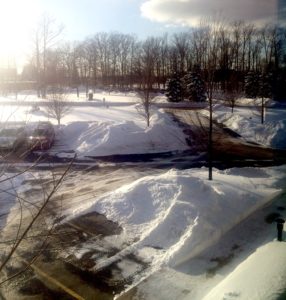Blue or SAD? Tackling Seasonal Affective Disorder
Posted in Health & Wellness on February 5, 2015
Just outside the Elk & Elk building, snow is piled several feet high and it’s causing many of us to suffer from the “winter blues.” However, for some people, changes in the seasons can bring on serious depression, known as seasonal affective disorder, or “SAD.”

“Landbergs” invade the Elk & Elk parking lot. Photo: LBC
What is SAD?
SAD is a type of depression related to changes in seasons. Most people who suffer from SAD start experiencing symptoms in the fall, which continue into the winter months and end in the spring.
Brought on by a lack of sunlight and exercise, SAD occurs globally, but is more common among people who live closer to the north or south poles. Here in Northeast Ohio, SAD rates are particularly high due to the region’s heavy cloud cover.
“We were the third highest city in the country that was affected by Seasonal Affective Disorder,” said Cleveland Clinic psychiatrist Karen Jacobs in a WKYC interview.
SAD Symptoms
People suffering from SAD often describe feeling moody and experience a loss of energy. According to the Cleveland Clinic website, symptoms of SAD may include:
- Sadness
- Anxiety
- Irritability
- Loss of interest in usual activities
- Withdrawal from social activities
- Inability to concentrate
- Extreme fatigue and lack of energy
- A “leaden” sensation in the limbs
- Increased need for sleep
- Craving for carbohydrates, and accompanying weight gain
Treatment for Seasonal Affective Disorder
Treatment for SAD may include light therapy (phototherapy), psychotherapy and medications. You can augment these treatments with simple lifestyle changes, including making your environment brighter (open those blinds!), getting outside (even on cloudy days) and exercising regularly.
It is important to remember that Seasonal Affective Disorder is a subtype of major depression. Be sure to contact a mental health professional if you or a loved one experiences symptoms for an extended period of time, have changes in sleep patterns or appetite, feel hopeless, think about suicide, or try to cope by abusing drugs or alcohol.
Source:
“Winter sparks high rates of depression in Northeast Ohio” by Will Ujek, WKYC-TV, February 3, 2015.